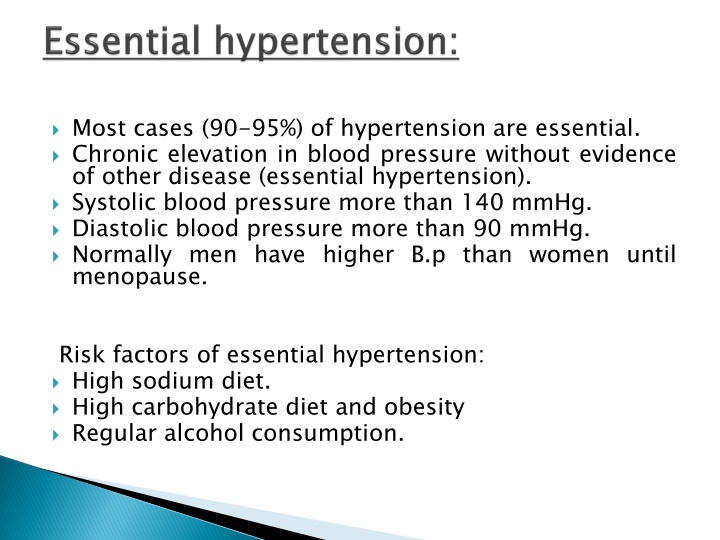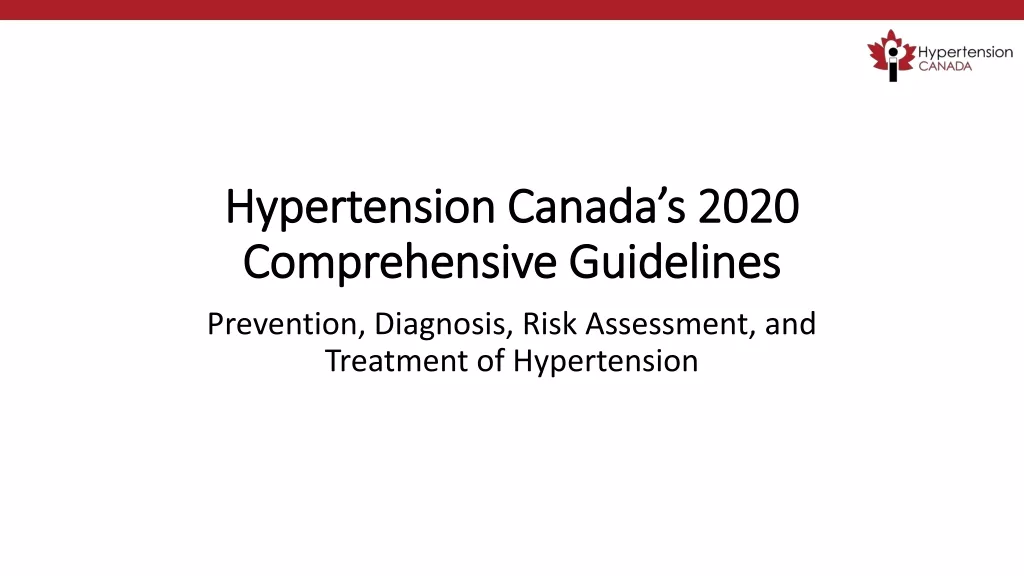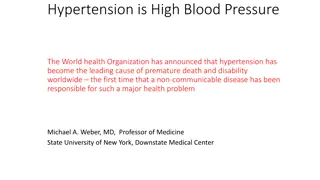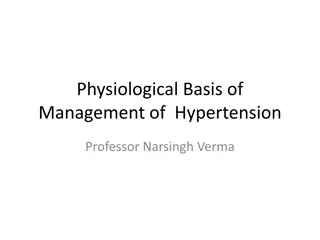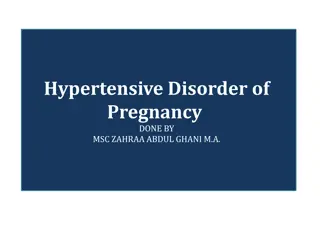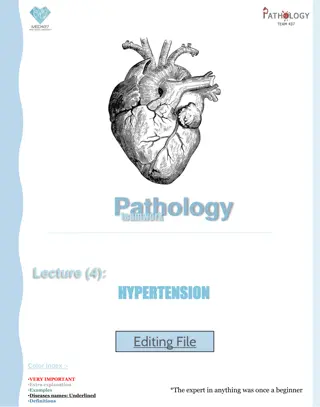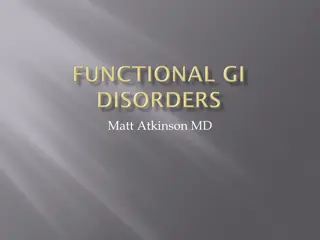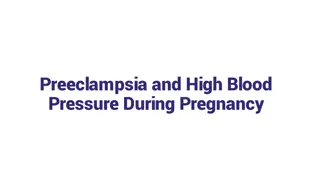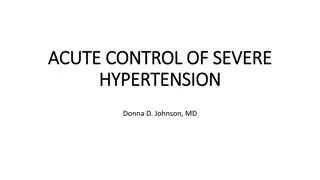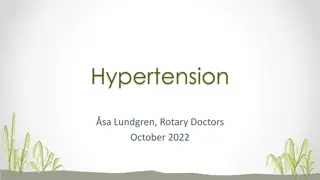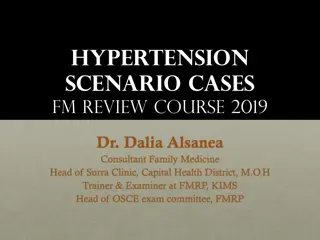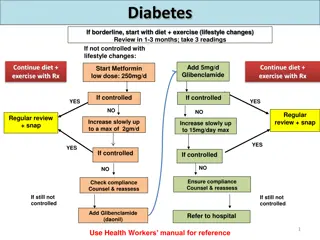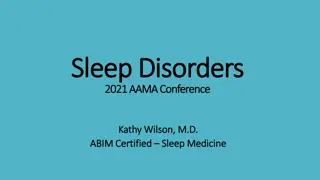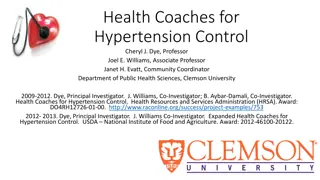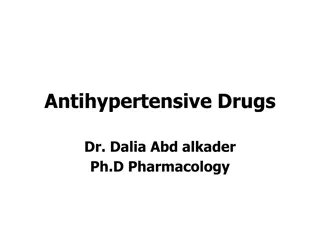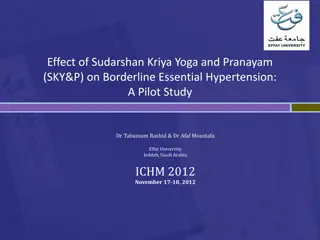Hypertension and Related Disorders
Hypertension is a common condition characterized by chronic high blood pressure. Essential hypertension constitutes the majority of cases, while secondary hypertension is due to underlying diseases. Learn about the risk factors, complications, and management of hypertension and related conditions such as orthostatic hypotension.
Download Presentation

Please find below an Image/Link to download the presentation.
The content on the website is provided AS IS for your information and personal use only. It may not be sold, licensed, or shared on other websites without obtaining consent from the author.If you encounter any issues during the download, it is possible that the publisher has removed the file from their server.
You are allowed to download the files provided on this website for personal or commercial use, subject to the condition that they are used lawfully. All files are the property of their respective owners.
The content on the website is provided AS IS for your information and personal use only. It may not be sold, licensed, or shared on other websites without obtaining consent from the author.
E N D
Presentation Transcript
Most cases (90-95%) of hypertension are essential. Chronic elevation in blood pressure without evidence of other disease (essential hypertension). Systolic blood pressure more than 140 mmHg. Diastolic blood pressure more than 90 mmHg. Normally men have higher B.p than women until menopause. Risk factors of essential hypertension: High sodium diet. High carbohydrate diet and obesity Regular alcohol consumption.
1. Atherosclerosis. 2. Predispose to all atherosclerotic disorders as heart stroke, MI. 3. workload hypertrophy of heart muscle hypoxia of heart muscle due to increase metabolic demands ischemia MI. 4. Arrhythmias and CHF. 5. Nephrosclerosis renal failure. 6. Accelerate course of diabetic nephropathy, especially type I.
Hypertension : due to another disease condition, constitutes (5-10%) of hypertension population. 1- Renal hypertension caused by renal diseases as: Glomerulonephritis. Acute renal failure. Acute urinary tract obstruction. All these lead to hypervolemia hypertension. 2- Diabetic nephropathy and pyelonephritis also may lead to secondary hypertension. 3- Disorders of adrenocorticosteroids such as: Conn s disease: increase secretion of aldosterone. Cushing syndrome: increase secretion of corticosteroids. Pheochromocytoma scattered in retroperitoneal. : chatecholamines secreting cells
Orthostatic (postural ) is an abnormal drop in blood standing position. After the assumption of the upright posture from the supine position. Approximately 500 to 700 ml of blood is momentarily shifted to the lower part of the body central blood volume and arterial pressure. Normally, this decrease in B.p is transient because located in thorax and carotid sinus area. pressure on assumption of the with an accompanying decrease in of stimulation of baroreceptors
Compensatories by baroreceptors stimulation: vasoconstriction in peripheral Tissue level Blood return to Central vein ADH H.R water retention B.p return to normal C.O.P
1- Reduced blood volume: Mostly due to excessive use of diuretics, excessive diaphoresis, loss of gastrointestinal fluid through vomiting and diarrhea and loss of fluid volume associated with prolonged bed rest. All these venous return hypotension. 2- Drug- induced hypotension: Antihypertensive drugs and psychotropic drugs are a common cause of chronic orthostatic hypotension.
3- Aging: several deficiencies in the circulatory response may predispose to this problem in elderly, including diminished ability to produce an adequate increase in heart rate, ventricular stroke volume, or peripheral vascular resistance. Decreased function of skeletal muscle pumps and decreased blood volume hypotension. water intake along with diuretics B.p hypotension. Bed rest and immobility: 4- decrease in venous tone, failure of peripheral vasoconstriction, muscle venous return hypotension. 5- function Prolonged bed rest and weakness plasma volume, skeletal of Disorders of autonomic nervous system
6- Orthostatic autonomic neuropathies associated with D.M, after injury or disease of the spinal cord, or as the result of a cerebral outflow from the brain stem is disrupted. hypotension function is caused by peripheral altered is common in vascular accident in which sympathetic Manifestations 1. B.p. 2. Dizziness 3. Syncope (fainting). Manifestations of of orthostatic orthostatic hypotension hypotension: :
An aneurysm is an abnormal localized dilation of a blood vessel. Aneurysm can occur in different types of arterial vessels, but they are most common in the aorta.
The two most common causes of aortic aneurysm are: 1- Atherosclerosis 2- Degeneration of the vessel Tunica media. Several conditions weaken the vessel wall; including: 1-Congenital defects 2-Trauma 3-Infections. Infection of a major artery that weakens its wall gives rise to Mycotic Aneurysm, due to arrest of septic embolus. because of arterial thinning through destruction of vessel media. In atherosclerosis, aneurysms occur
Once aneurysm is initiated diameter of blood vessel tension in the wall of the vessel in direct proportion to its increased size aneurysm may rupture or damage , even an unruptured aneurysm can cause damage of adjacent tissue or cause: Turbulence, endothelium thrombus formation. Also, pain, discomfort, severe abdominal or back pain radiates to the posterior aspects of legs. which leads to injuring of
dilated, extremities often lead to secondary problems of venous insufficiency. Varicose veins are classified into: 1. Primary; saphenous veins. 2. Secondary; results from impaired flow in the deep venous channels. A torturous veins of the lower originates in the superfacial
Causes common in obese persons, in pregnant women due to prolonged standing vein valves become incompetent properly. Causes Deep venous thrombosis (DVT) Pressure pregnancy, tumor or arteriovenous fistula. Pathophysiology Varicose superficial ulceration. Venous necrosis of subcutaneous connective tissue may cause ulcer eventually. Also, hemosiderin. Causes of of primary primary varicose varicose veins veins: : it is more so they are no longer closed Causes of of secondary secondary varicose varicose veins veins: : on the abdominal veins, caused by Pathophysiology of of varicose leads varicose veins to veins: : edema. veins If they are insufficiency, due to DVT edema there are brown discoloration due to
